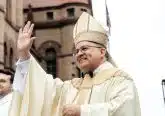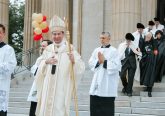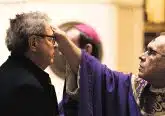Where the Bishop Is, the Church Is
I write this month to congratulate Bishop-elect Earl Fernandes on his impending consecration as Bishop of the Diocese of Columbus, OH. When he assumes the bishop’s chair (the cathedra), Bishop-elect Fernandes will join an unbroken succession of bishops that dates from the Church’s very first days. And, by virtue of his office, he will represent all Catholics of his diocese. Father Earl’s elevation has special meaning to me for a couple of reasons. First, his 2016 appointment to the Apostolic Nunciature led to my position at Mount St. Mary’s Seminary & School of Theology. (That’s a story for another time.) Second, the historical and theological importance of the office of bishop is at the heart of my journey to the Catholic Church.
As I moved toward conversion to Catholicism from an American evangelical tradition, among my most important considerations were the Church structure and the issue of authority. The tradition from which I converted claims to be a “restoration” of the Church as it existed in the earliest days of Christianity – the Church of the “New Testament” it sometimes calls itself. And it insists that the Bible is “the only rule of faith and practice,” a variation on the Protestant notion of sola scriptura. Like several faith traditions founded in the early 19th Century, it asserts that it is governed solely by the Bible, not by any person. These traditions recognize neither ecclesial hierarchy nor authoritative magisterium, claiming they are not found in the New Testament or in the early Church and that if something isn’t found in the Bible, it is not to be held or practiced.
My journey to the Catholic Church began when I realized these assertions are not only contrary to the structure and practice of the early Church, but also theologically and historically incoherent. Two glaring problems presented themselves to me.
CANON OF SCRIPTURE
First, in its earliest days the Church did not have a canon of Scripture, as we understand that term. Thus, traditions saying the Bible is the only rule of faith and practice also claim to model themselves on a Church that did not even have the Bible. To really “restore” the Church of the New Testament era, these traditions have to jettison the New Testament, because that Church did not have one. The assertion that “the Bible is the only rule of faith and practice in the early Church” does not come from the Bible, because there was no Bible from which to derive the claim. In reality, for these traditions the individual is the only rule of faith and practice. Moreover, the Bible this tradition now claims to be its sole authority makes no such claim for itself. Thus, the claim that the Bible is the only authority must come from some authority other than the Bible. This contradiction, of course, demonstrates that the Bible is not even the highest authority for these quintessentially American churches, much less the only authority.
THE CHURCH’S STRUCTURE
The second problem I discovered was that these traditions’ claim that the earliest Church did not have an authoritative, hierarchical magisterium is historically wrong. Indeed, by the late 1st Century, a clearly recognized structure of bishop, priest, and deacon was well established, as evidenced by men who directly learned from some of the 12 apostles. So, the tradition from which I converted claims the authority of the Bible where there was no Bible, and it claims to have no hierarchical structure while “restoring” a Church that had a clear hierarchical structure.
When Bishop-elect Fernandes assumes his role as Bishop of Columbus, he will follow in the tradition of St. Ignatius of Antioch, a late 1st Century bishop who clearly articulated the already well-established ecclesial structure of the early Church – a Church that preceded the Christian Bible by about 300 years. With St. Clement of Rome and St. Polycarp of Smyrna, St. Ignatius is one of three bishops and two additional authors, known as the “Apostolic Fathers,” because they were contemporary with some of the Twelve. St. Ignatius wrote a series of letters while traveling to Rome for his execution, giving instructions to churches in other cities regarding the nature of ecclesial structure and magisterial authority, all of which are centered in the bishops.
In one letter, for example, St. Ignatius exhorts Christians “to follow the bishop, even as Jesus Christ does the Father, and the presbytery as you would the apostles; and reverence the deacons, as being the institution of God.” These offices of bishop, priest and deacon existed long before the New Testament, and they provided both the form and substance of early Christian doctrine, including the doctrine that developed into the canon of Scripture.
Moreover, the bishop has the special role of representing the Christians of his see. “Wherever the bishop appears,” explained St. Ignatius, “there let the people be; as wherever Jesus Christ is, there is the Catholic Church.” In this earliest known use of the term “Catholic” to describe the Church, St. Ignatius reflects the Church’s developed understanding that the bishop is Christ’s vicar, and the head of the local Church.
Thus, all the Church’s ministry is conducted by the bishop, or one who the bishop appoints in his stead. “Let no man do anything connected with the Church without the bishop,” exhorted St. Ignatius. “Let that be deemed a proper Eucharist, which is [administered] either by the bishop, or by one to whom he has entrusted it.” Bishop-elect Earl Fernandes will join in the august company of bishops who have guided the Church through the centuries. I have high confidence that he will serve well and hope that he will serve long.

Dr. Kenneth Craycraft is an attorney and the James J. Gardner Family Chair of Moral Theology at Mount St. Mary’s Seminary & School of Theology.
This article appeared in the June 2022 edition of The Catholic Telegraph Magazine. For your complimentary subscription, click here.













